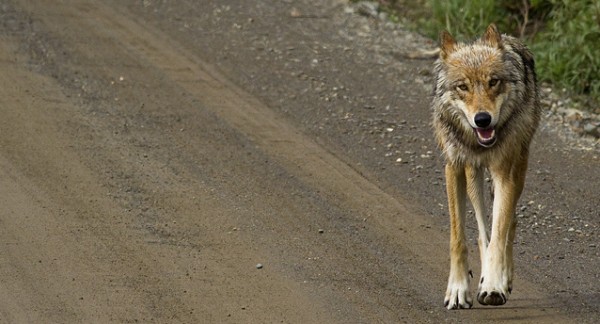
Wolf sightings hit a record low along the road into Denali National Park this summer, and that’s driving wildlife advocates to push for a halt of wolf hunting and trapping on state lands along Denali’s northeastern boundary, where park road area wolves often roam, and are sometimes killed.
A report recently issued by the National Park Service, shows only 1 percent of agency wildlife survey trips along the road into Denali National Park this summer recorded wolf sightings.
Park biologist Bridget Borg says that’s the worst number since trained park observers began officially tracking wildlife sightings along the road into Denali in the mid-1990s. Viewing percentages previously ranged from as low as 3 percent and as high as 45 percent. Borg says the currently poor wolf sighting percentage is likely primarily representative of natural factors.
“Just there being a lot of variability in where wolves den, and the size of packs over the years,” she said. “Not to say there aren’t the potential for other things to influence that outside of the park.”
Biologist and wildlife advocate Rick Steiner has been trying unsuccessfully for years to get the state to close wolf hunting and trapping on state lands along Denali’s northeastern boundary. Steiner points to the damaging impact loss of an alpha wolf can have on a pack, and makes an economic argument for why the state should care, correlating recent poor wolf viewing opportunity with dips in Denali visitor numbers and spending.
“This is kind of the goose that laid the golden egg for Alaska — if we protect it and help restore it,” he said.
Half a million people visit Denali annually, but there’s state resistance to curtailing boundary area wolf harvest by a few hunters and trappers. Closure requests from Steiner and other Alaskans have been regularly turned down. Commissioner of Fish and Game Doug Vincent Lang recently rejected the second of 2 such petitions submitted since July. Commissioner’s spokesperson Rick Green explains why.
“Data from the Parks Service isn’t a very specified area, and when we manage we manage more of a habitat area — much larger scale — and haven’t seen the evidence to constitute an emergency on the wolf population,” he said.
Green says that means it’s an allocation issue and up to the game board, which has consistently failed to grant requests to re-establish a no wolf kill area, scrapped by the board in 2010. In a July interview, game board chair Ted Spraker pointed to wolves’ resilience, and the potential for wolf viewing to rebound.
“It could all change next year if one of these eastern packs dens close to the road,” he said.
But halting wolf hunting and trapping in the nearby northeast boundary area could also help, according to the Park Service’s Borg. She points to better wolf viewing during a decade long span when boundary area wolf harvest was closed.
“When the area adjacent to the park was closed to hunting and trapping, it was correlated with higher sightings, so we think that bears replication to see if there’s a similar effect,” she said.
The park service and wildlife advocates have submitted separate northeast park boundary no wolf kill buffer proposals to the game board for consideration at a March 2020 meeting, but any change would take place after the wolf trapping season. Steiner is pushing for an emergency game board meeting prior to the November first start of trapping season.
Dan Bross is a reporter at KUAC in Fairbanks.




